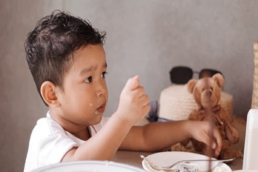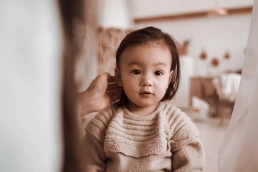During the second month of a baby’s life, remarkable developments and milestones unfold. At this stage, infants start to display increased alertness and responsiveness to their surroundings. You’ll notice enhanced visual tracking as they follow objects with their eyes, demonstrating a growing awareness of the world. Many babies begin to engage in more vocalizations, cooing, and babbling in their adorable way. Physical advancements also become evident as they gain better head control during tummy time. It’s a time of rapid growth and exploration for these little ones, laying the foundation for future developmental leaps.
Table of Contents
ToggleWhat are the Baby’s Development and Milestones on the 2nd Month
The second month of a baby’s life is marked by remarkable developmental milestones, showcasing their rapid growth and emerging abilities. Understanding these milestones allows parents and caregivers to support and celebrate their infant’s progress.
Physical Development
- Neck Control. By the second month, many babies can lift their heads momentarily while lying on their stomachs, demonstrating improved neck control.
- Hand and Eye Coordination. Your baby’s hand-eye coordination is developing as they start to track objects with their eyes and may even swipe at hanging toys.
Social and Emotional Development
- Social Smiles. At around two months, your baby may reward you with their first social smiles, indicating an emerging ability to respond to facial expressions.
- Cooing Sounds. The second month often sees the introduction of cooing sounds as your baby begins to experiment with vocalizations.
Sensory Development
- Focused Gaze. Babies at this stage can focus on faces and objects, showing an increased visual acuity and interest in their surroundings.
- Responsive to Sounds. Your baby becomes more responsive to sounds, turning their head towards voices and other auditory stimuli.
Feeding Milestones
- Increased Feeding Efficiency. With improved sucking reflexes, your baby may become more efficient at breastfeeding or bottle-feeding.
- Established Feeding Schedule. By the second month, you might notice a more predictable feeding schedule as your baby establishes routines.
Sleep Patterns
- Longer Sleep Stretches. While sleep patterns can still vary, some babies may start to consolidate their sleep into longer stretches during the night.
- More Alert during Wakefulness. When awake, your baby is more alert and engaged with their surroundings, showing increased interest in faces and stimuli.
What are the activities needed to Support your 2-month-old baby’s development
Supporting the development of a two-month-old baby involves incorporating various activities that stimulate their senses and encourage physical and social growth. Here are some activities to consider:
Tummy Time
- Place the baby on their tummy for short periods to help strengthen neck and upper body muscles.
- Use colorful toys or a mirror to capture their attention during tummy time.
Face-to-Face Interaction
- Engage in face-to-face interactions, making eye contact, and using animated facial expressions.
- Talk to your baby in a soothing voice to encourage language development.
High-Contrast Toys
- Introduce black-and-white or high-contrast toys to stimulate the baby’s developing vision.
- Hang a mobile with bold patterns above the crib.
Soft Rattles and Toys
- Offer soft rattles and toys that are easy for the baby to grasp.
- Gently shake these items to capture their interest.
Gentle Music
- Play soft and calming music to create a soothing atmosphere.
- Hold the baby close while listening to music to promote a sense of security.
Reading Aloud
- Read simple, colorful board books to the baby.
- Choose books with contrasting images and textures.
Baby Massage
- Incorporate gentle baby massage using baby-safe oils.
- This can promote relaxation and bonding between you and your baby.
Sensory Play
- Provide opportunities for sensory exploration, such as feeling different textures with their hands.
- Use soft fabrics or textured toys during playtime.
Soft Play Gym
- Place the baby under a soft play gym with hanging toys.
- This encourages reaching and batting movements, enhancing motor skills.
Mimicking Sounds
- Mimic the sounds your baby makes, encouraging them to engage in back-and-forth “conversations.”
How to Feed Your 2-Month-Old Baby
Feeding your 2-month-old baby involves a delicate balance of nourishment, comfort, and bonding. As your baby continues to grow, their feeding needs evolve, and understanding the best practices for feeding ensures their optimal health and well-being.
Breastfeeding
- Positioning. Ensure a comfortable breastfeeding position for both you and your baby. Use pillows for support and aim for a relaxed and calm environment.
- Latching. Achieving a proper latch is crucial for efficient breastfeeding. Ensure your baby’s mouth covers a significant portion of the areola, promoting effective sucking.
- Feeding Frequency. At 2 months, your baby may still feed every 2-3 hours, including nighttime feedings. Pay attention to hunger cues and feed on demand.
Bottle-feeding (Formula or Expressed Breast Milk)
- Sterilization. If using bottles, maintain strict hygiene by sterilizing bottles and nipples before each use. Follow the manufacturer’s guidelines for proper sterilization.
- Holding the Bottle. Hold the bottle so that the nipple is filled with milk to prevent air intake. This minimizes the risk of gas and colic.
- Pace Feeding. Encourage paced bottle feeding by allowing your baby to suck and swallow at their own pace. This mimics the natural breastfeeding experience.
Responsive Feeding
- Watch for Hunger Cues. Be attentive to your baby’s hunger cues, such as rooting, sucking motions, or increased alertness. Respond promptly to these cues to ensure timely feedings.
- Burping. Whether breastfeeding or bottle-feeding, pause to burp your baby midway through and after each feeding to release any swallowed air.
- Skin-to-Skin Contact. Incorporate skin-to-skin contact during and after feedings. This not only enhances the bonding experience but also regulates your baby’s body temperature.
Nighttime Feedings
- Dim Lighting. During nighttime feedings, keep the lights dim to maintain a calm and soothing environment. Minimize interaction to help your baby return to sleep quickly.
- Comfortable Sleep Space. Ensure your baby’s sleep space is conducive to nighttime feedings, with easy access to diapers and a comfortable feeding chair or bed.
How Much Sleep Does Your 2-Month-Old Baby Need
Understanding the sleep needs of your 2-month-old is crucial for their overall development and your well-being as a parent. While sleep patterns can vary, establishing healthy sleep habits contributes to a more restful night for both you and your baby.
Nighttime Sleep
- Sleep Duration. At 2 months, your baby may sleep for about 14-17 hours in 24 hours. Nighttime sleep typically ranges from 8 to 9 hours, broken into shorter stretches.
- Night Wakings. Expect your baby to wake every 2-3 hours during the night for feedings. This pattern aligns with their nutritional needs and helps support healthy weight gain.
Daytime Naps
- Nap Duration. Daytime naps can vary, with some babies taking shorter 30-minute naps, while others may enjoy longer stretches of 2-4 hours.
- Total Nap Time. On average, your 2-month-old may nap for 4-6 hours throughout the day, distributed across multiple naps.
Creating a Sleep-Friendly Environment
- Consistent Bedtime Routine. Establish a soothing bedtime routine to signal the transition from wakefulness to sleep. This may include activities like a warm bath, gentle massage, or soft lullabies.
- Comfortable Sleep Space. Ensure your baby’s sleep space is safe and comfortable, and adheres to recommended sleep guidelines. Use a firm mattress, remove loose bedding, and maintain a comfortable room temperature.
Day in the Life of a 2-Month-Old Baby
Feeding
- 6-8 feedings a day
- Feeding sessions last around 15-20 minutes during breastfeeding or 2-5 ounces per bottle
- Pacifier can be considered after breastfeeding
- Night-time feedings are expected every 2-3 hours
Sleeping
- 14-17 hours of sleep in 24 hours, including 4-6 naps
- Day-night confusion is slightly subsiding
- Babies are beginning to establish a bit of a routine
- Highly responsive to their environment
Bathing
- 2-3 times a week is typically enough to keep your baby clean
- Babies typically can have sponge baths at this age
- Position the bath somewhere stable where you can comfortably hold your baby
- The water should be warm, but not hot
Changing Diapers
- Experts recommend changing your baby’s diaper every 2-3 hours
- Signs of Wet Diaper. Pay attention to signs that your baby’s diaper may be wet or dirty, such as restlessness, fussiness, or a soiled diaper odor
- Apply a thin layer of diaper cream or ointment every diaper change to protect their skin
Playing
- Soft lullabies or calming music can enhance the playtime atmosphere
- Introduce baby-safe mirrors to your baby to help them with self-recognition and visual exploration
- Provide babies with soft toys that they can grasp and explore
Fun Facts
- Babies are becoming more alert and responsive
- Babies beginning to develop the ability to grasp objects, although their coordination is still in the early stages
Baby’s Health at 2-Month-Old
Growth
- By 2 months, babies have typically gained a significant amount of weight and may be looking round and chubby. They continue to grow at a rapid rate, gaining about 900g and growing 2.5cm to 3.8cm every month
Physical Development
- At 2 months, babies are starting to lift their heads and move from side to side. They are also discovering their fingers and hands, and their arms and legs are moving more freely. They may start to kick both legs strongly and become very wriggly
Common Health Concerns
- Vaccinations. At 6 to 8 weeks, babies will have their scheduled vaccinations, which include three injections and the oral rotavirus vaccine
- Colic. Some babies may experience colic, which is excessive crying that lasts for several hours a day. This can be distressing for both the baby and the parents
- Diaper Rash. Diaper rash is a common concern for babies at this age, as they are still in diapers for most of the day. To prevent diaper rash, change your baby’s diaper promptly when wet or soiled, and apply a thin layer of diaper cream or ointment to protect their skin
- Sleep Issues. Some babies may have trouble sleeping through the night or may wake up frequently. This can be due to a variety of factors, including hunger, discomfort, or a need for comfort and reassurance
- Feeding Issues. Some babies may have trouble with feeding, such as difficulty latching or swallowing. This can be due to a variety of factors, including tongue-tie or reflux
Social and Emotional Development
- At this age, babies enjoy looking at faces and will give lovely smiles. They are becoming more alert and responsive to their surroundings, and they may start to show more curiosity and react to their caregivers with smiles
Sensory Development
- Babies at this age are captivated by high-contrast patterns and vibrant hues. They are also starting to track moving objects with their eyes and may enjoy looking at themselves in a baby-safe mirror
Development Tips for 2-Month-Old Baby
Tummy Time
Initiate short sessions of tummy time several times a day. This helps strengthen your baby’s neck and upper body muscles, laying the foundation for future motor skills.
High-Contrast Stimuli
Babies at this age are drawn to high-contrast patterns. Use black-and-white toys or images to capture their attention and stimulate their developing vision.
Face-to-Face Interaction
Engage in face-to-face interactions with your baby. Make eye contact, smile, and talk to them in a soothing voice. This helps strengthen the bond between parent and baby and encourages social development.
Soft Toy Exploration
Introduce soft and textured toys for your baby to explore. Babies are starting to develop their grasping reflex, and soft toys provide a safe and enjoyable tactile experience.
Gentle Music and Sounds
Expose your baby to gentle music and soothing sounds. This not only creates a calming environment but also contributes to their auditory development.
Encourage Tracking Movements
Hold a colorful or interesting object slightly above your baby’s line of sight and move it slowly from side to side. This encourages them to track the movement with their eyes, promoting visual tracking skills.
Skin-to-Skin Contact
Foster a sense of security and comfort through skin-to-skin contact. Hold your baby against your chest, providing warmth and reassurance.
Cooing and Responding
Your baby may start making cooing sounds. Respond to these vocalizations with smiles and gentle conversation. This back-and-forth interaction supports their emerging communication skills.
Be Attuned to Cues
Pay close attention to your baby’s cues. Whether it’s a cry indicating hunger or a gurgle signaling contentment, responding promptly helps build trust and security.
Maintain a Routine
Establish a gentle daily routine. Predictable patterns can be reassuring for your baby and may contribute to better sleep and feeding habits.
Create a Calm Sleep Environment
Ensure your baby’s sleep environment is calm and conducive to rest. Dim the lights during nighttime feedings and keep the room comfortably cool.
Items Needed on the 2nd Month of Your Baby
Diaper Bag (pack it with)
- Diapers
- Fragrance-free baby wipes
- Changing mat
- Spare clothes
- Baby nail clippers
Clothing
- Onesies
- Sleepers
- Socks
- Hats suitable for the weather
Swaddle Blankets
- Breathable swaddle blankets
Baby Gear
- Bassinet or crib
- Stroller
- Baby carrier
- Sling
Feeding Supplies
- Bottles
- Nipples
- Breast pump (if applicable)
- Burp cloths
Baby Toiletries
- Gentle baby soap
- Baby shampoo
- Baby lotion
Thermometer
- Digital thermometer
Pacifiers
- Pacifiers
Baby Monitor
- A baby monitor with audio and video capabilities
Breastfeeding Pillow (if breastfeeding)
- Nursing pillow
Laundry Detergent for Babies
- Hypoallergenic and fragrance-free laundry detergent
Baby Bathtub and Towels
- Bathtub
- Soft hooded towels
Life as a Parent on Baby’s 2nd Month
Entering the second month of parenthood has been a whirlwind of emotions, challenges, and heartwarming moments. The nights are a delicate dance of sleepless tenderness, filled with the soft murmurs and cries of our newborn. Diapers have become an integral part of our daily routine, scattered like a trail of evidence of a life redefined. In the hushed darkness, we find ourselves navigating the labyrinth of feedings, diaper changes, and the gentle rocking that soothes our little one back to slumber. Each day is a new chapter in understanding the needs and nuances of our baby, from the first morning smiles to the adorable gurgles that echo through our home.
Our days are now intricately woven with the threads of routine and unpredictability. The once-familiar rhythms of our lives have shifted to accommodate the demands of parenthood. Yet, amidst the fatigue and challenges, there is an indescribable joy in witnessing the blossoming personality of our tiny human. The second month has brought a deeper connection as we learn to interpret the cues and quirks of our baby. Parenthood in this phase is a dance of adaptation and resilience, finding solace in the simplicity of shared glances and the warmth of our baby’s presence.
As parents, we are learning to balance the fragility of our newborn’s needs with the strength required to face the uncertainties of this journey. It’s a chapter marked by sleepless nights and tender snuggles, by the challenge of deciphering each cry and the joy of witnessing the first hints of our baby’s emerging character. In the midst of it all, we are discovering that parenthood in the second month is a tapestry of love, growth, and the profound beauty of embracing the unpredictable symphony of life with our little one.
Checklist for the 2nd Month of Your Baby
2-Month Checkup
- During this visit, your baby will receive several immunizations, including the Hepatitis B vaccine (HBV), Rotavirus vaccine,
- Diphtheria, tetanus, acellular pertussis vaccine (DTaP), Haemophilus influenzae type B vaccine (Hib), Pneumococcal conjugate vaccine, and Inactivated polio vaccine (IPV)
Growth and Development
- Your pediatrician will measure and weigh your baby to ensure their growth is on track, observe their development and behavior, and perform a physical exam
Responsive Parenting
- Spend time cuddling and holding your baby to make them feel safe and cared for
Self-Care
- Take care of yourself as a parent, as it’s essential to feel good to enjoy your new baby
Safe Sleep
- Put your baby on their back in a safe sleep area (firm mattress with no blankets, pillows, bumper pads, or toys) when they seem sleepy
Multiple Vaccinations
- If your baby receives multiple vaccinations at once, it’s safe and sometimes recommended due to the combination of some shots
Last Updated on January 15, 2024
Written By
With a solid foundation in family dynamics, child development, and a knack for assessing products, our content is built on a strong grasp of our topics. We use trustworthy sources, seek advice from experts, and stay current with the latest happenings in our fields. We always give credit to our sources, reveal any possible conflicts of interest, and deliver info in a truthful and unbiased way. Follow us on Facebook or join our Facebook Group.
Start your journey to confident parenting
Join over 2,000+ parents who receive free practical advice and tips from Joyful PH. Unsubscribe anytime.
You may also like
Toddler’s Development and Milestones at 24th Month
A two-year-old's growth and achievements at 24 months are remarkable. Toddlers…
Toddler’s Development and Milestones at 23rd Month
In the 23rd month, toddlers exhibit significant developmental strides. Their…
Toddler’s Development and Milestones at 22nd Month
At 22 months, toddlers make strides in independence, speech, and motor skills.…
Toddler’s Development and Milestones at 21st Month
During the 21st month, toddlers continue their dynamic development. Language…
Toddler’s Development and Milestones at 20th Month
At 20 months, toddlers exhibit remarkable progress. Their language skills…
Toddler’s Development and Milestones at 19th Month
A toddler at 19 months undergoes significant development. Language skills…







